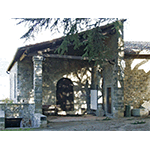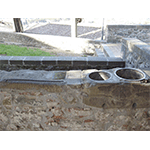Museo Civico del Territorio "Antonio Mordini" - Palazzo Pretorio ["Antonio Mordini" Civic Museum of the Territory - Palazzo Pretorio]
The Museum opened in December 1993 in Palazzo Pretorio, the oldest, still-existent public building. The Palazzo and the old prison beneath it were built in the first half of the 14th century to house the Podestà (hence it is popularly known as the "Loggetta del Podestà"), that is to say the governor that Florence sent to Barga to administer the territory and justice. The city was indeed under Florentine protection as of 1341 or 1342 until the Unification of Italy. A curiosity: in 1631, Galileo’s son Vincenzio was destined, despite his wishes, to the Chancery of Barga.
On the low wall that separates the loggia from the stairs leading to the old prison, you can observe the old measurements used in the city in 1582: the lengths of the "Florentine arm" (0.583 metres) and of the "coltello", that is the measurement of a knife that citizens could carry for self-defence (1/4 of an arm, corresponding to 14.5 centimetres), and the measurements of the "Florentine half bushel" (12.2 litres) and of the "Florentine bushel" (24.4 litres) used to measure grain.
The Museum forms an itinerary to acquaint visitors with the territory of Barga and its specificities from the naturalistic, historical and artistic viewpoints. Its layout is of the educational type with panels accompanied by photographs, drawings and graphic reconstructions. The historical aspects, from the prehistorical age to the early Renaissance, are illustrated by archaeological finds, vestments and church plate, paintings and sculptures.
The more properly scientific themes are presented in a section dedicated to geology and palaeontology, where the features of the territory are presented with stratigraphies of rocks and indications concerning the evolutionary phases of their formation. Environmental reconstructions provide indications on the flora and fauna present in various periods. The palaeontological collection is fruit of the research of the Mineralogical and Palaeontological Group of Fornaci di Barga, which contributed to creating the first nucleus of the Museum. Fossil finds collected as of 1973 come from the Serchio Valley and from the Pisan Mountains, and have been catalogued by the Geology and Palaeontology Section of the Museum of Natural History of the University of Florence. Particularly worthy of note are the molars of Elephas africanus.
Walking down into the old prison, one can admire the nineteenth-century clockwork of the bell tower of the Cathedral of Barga. Outside, on the wall supporting the roof of the Loggetta del Podestà, one notes the gnomon of a sundial (the meridian altitude is missing), made in the mid 18th century by engineer Giorgio Kindt, "professor of Sundials". As in many other cases, sundials of this type were used to set the public mechanical clocks.
****************************
Texts by Graziano Magrini
English translation by Victor Beard
Last update 08/gen/2008





